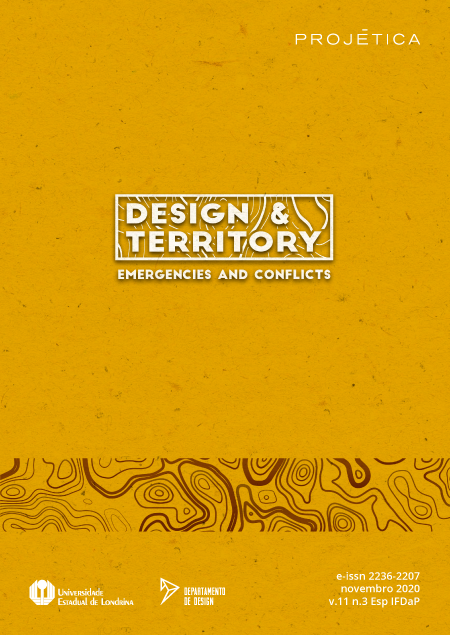Emotional design model as alternative for access of products from Huila to Colombian coffee market
DOI:
https://doi.org/10.5433/2236-2207.2020v11n3esp.p225Keywords:
Emotional Design, Coffee Culture, Kansei Engineering, Properties Space, Semantic DifferentialAbstract
The cluster of coffee in Colombia is distinguished by two sub - nucleus that constitutes character of consolidated product in two ways: those coffee nucleuses which line reaches the marketable product with accepted national reference level identity and ruled by “coffee culture”, and those producers who are primarily suppliers of the previous ones since its strength is not in intervention strategies development from design. The present investigation exposes the application of design methodology by Kansei engineering (KE) focused on aesthetic-formal development of products that connect emotionally with consumers inside the coffee cluster of Huila, Colombia. Methodology follows the Design for Aesthetics technique, the result is a set of statistics relations between emotional impressions of the potential consumers over a product and its aesthetic-formal properties. This methodology looks to build a model of briefing that allows develop products that connect with the user in an aesthetic-emotional way, by pretending to obtain a requirements and design parameters identification and definition, and to build a relation more accurate between products and consumers, as well. Methodology indicated is specified applying it to a coffee packaging design, developed for a new indigenous coffee brand, with the propose to create a high competitive product, with the advantage that is based on emotional linkage with potential customers.Downloads
References
AVENDAÑO PRIETO, Gerardo; ÁLVAREZ, Héctor René. Aplicación de la ingeniería kansei con redes neuronales. Avances Tecnológicos en Ingeniería, Cundinamarca, v. 1, n. 1, p. 7-27, 2013.
BRIEDE WESTERMEYER, Juan Carlos; CABELLO MORA, Marcela; HERNANDIS ORTUÑO, Bernabé. Modelo de abocetado concurrente para el diseño conceptual de productos industriales. Dyna, Bogotá, v. 81, n. 187, p. 199-208, 2014.
CÉSPEDES, Pablo Buriticá. La roya del cafeto en Colombia: Realizaciones de impacto nacional e internacional en el siglo XX. Revista Facultad Nacional de Agronomía Medellín, Medellín, v. 63, n. 1, p. 5285-5292, 2010.
CÓRDOBA-ROLDÁN, Antonio; AGUAYO-GONZÁLEZ, Francisco; LAMA-RUIZ, Juan. Ingeniería kansei: diseño estético de productos. Dyna, Bogotá, v. 85, n. 6, p. 489-503, 2010.
CROSS, Nigel. Métodos de diseño: estrategias para el diseño de productos. México DF: Limusa Wiley, 2005.
FEDERACIÓN NACIONAL DE CAFETEROS DE COLOMBIA. Nuestras regiones cafeteras. 2010. Disponible en: http://www.cafedecolombia.com/particulares/es/la_tierra_del_cafe/regiones_cafeteras/. Acceso en: 6 nov. 2019
HUANG, Yuexiang; CHEN, Chun-Hsien; KHOO, Li Pheng. Kansei clustering for emotional design using a combined design structure matrix. International Journal of Industrial Ergonomics, Amsterdam, v. 42, n. 5, p. 416-427, 2012a.
HUANG, Yuexiang; CHEN, Chun-Hsien; KHOO, Li Pheng. Products classification in emotional design using a basic-emotion based semantic. International Journal of Industrial Ergonomics, Amsterdam, v. 42, n. 6, p. 569-580, 2012b.
HUANG, Yuexiang; CHEN, Chun-Hsien; WANG, Cindy I-Hsuan; KHOO, Li Pheng. A product configuration analysis method for emotional design using a. International Journal of Industrial Ergonomics, Amsterdam, v. 44, n. 1, p. 120- 130, 2014.
KHEAN CHUAN, Ngip; SIVAJIA, Ashok; MOHAMAD SHAHIMIN, Mizhanim; SAADB, Nursyakinah. Kansei engineering for e-commerce sunglasses selection in Malaysia. Procedia: social and behavioral sciences, Rotterdam, v. 97, n. 6, p. 707-714, 2013.
NAGAMACHI, Mitsuo. Kansei engineering as a powerful consumer-oriented technology for product development. Applied Ergonomics, Guildford, v. 33, n. 3, p. 289-294, 2002.
NAGAMACHI, Mitsuo. Kansei engineering: a new ergonomic consumeroriented technology for product development. International Journal of Industrial Ergonomics, Amsterdam, v. 15, n. 1, p. 3-11, 1995.
NAGAMACHI, Mitsuo. Perspectives and the new trend of Kansei/affective engineering. The TQM Journal, London, UK, v. 20, n. 4, p. 290-298, 2008.
PAISAJE CULTURAL CAFETERO. Cultura cafetera: un paisaje productivo muy cultural. 2017. Disponible en: http://paisajeculturalcafetero.org.co/ contenido/Cultura-Cafetera. Acceso en: 6 nov. 2019.
PERKS, Helen; COOPER, Rachel; JONES, Cassie. Characterizing the Role of Design in New Product Development: An Empirically Derived Taxonomy. The Journal of Product Innovation Management, Hoboken, NJ, v. 22, n. 2, p. 111-127, 2005.
RIAÑO, Noelia Cigüenza. Huila es el departamento líder cafetero con 16% del área cultivada. La Republica, Bogotá, 18 mar. 2019. Dinponible en: https:// www.larepublica.co/especiales/ruta-del-cafe/huila-es-el-departamentolider-cafetero-con-16-del-area-cultivada-2840686. Acceso en: 6 nov. 2019.
SEMANATE QUIÑONEZ, Hugo Alexánder. Producción de café de alta calidad por comuneros de la comunidad indígena Yanacona en el sur del Huila – Colombia: un análisis de aglomeración espacial. Agroecologia: ciencia e tecnología, Huila, v. 2, n. 1, p. 6-4, 2014.
TRUEMAN, Myfanwy; JOBBER, David. Competing through design. Long Range Planning, London, UK, v. 31, n. 4, p. 594-605, 1998.
YANG, Sun-Mo; NAGAMACHI, Mitsuo; LEE, Soon-Yo. Rule-based inference model for the Kansei Engineering System. International Journal of Industrial Ergonomics, Amsterdam, v. 24, n. 5, p. 459-471, 1999.
Downloads
Published
How to Cite
Issue
Section
License
Projética está licenciada sob a Creative Commons Attribution CC-BY 4.0 International. Os autores detém os direitos autorais e concedem à revista o direito de exclusividade de primeira publicação.
Os autores dos trabalhos aprovados autorizam Projética a, após a publicação, ceder seu conteúdo para reprodução em indexadores de conteúdo, bibliotecas virtuais e similares.
Os autores assumem que os textos submetidos à publicação são de sua criação original, responsabilizando-se inteiramente por seu conteúdo em caso de eventual impugnação por parte de terceiros. As opiniões emitidas pelos autores dos artigos são de sua exclusiva responsabilidade.
A revista se reserva o direito de efetuar, nos originais, alterações de ordem normativa, ortográfica e gramatical, com vistas a manter o padrão culto da língua e a credibilidade do veículo. Respeitará, no entanto, o estilo de escrever dos autores. Alterações, correções ou sugestões de ordem conceitual serão encaminhadas aos autores, quando necessário. Nesses casos, os artigos, depois de adequados, deverão ser submetidos a nova apreciação. As provas finais não serão encaminhadas aos autores.











